The most efficient workout and the most versatile tool for shoulder workout is bodyweight.
Bodyweight exercises use your own weight to make your shoulders strong and stable at home without machines, dumbbells, or barbells.
The beauty of bodyweight training is that it’s the OG (original) way humans got strong, long before gyms existed.
The right progressions and a little creativity can transform your shoulder muscles beyond what you think is possible.
In this blog post, we’ll show you the best bodyweight exercises that target all heads of the shoulders from multiple angles.
Get ready to sculpt your delts and achieve those shoulder goals!”
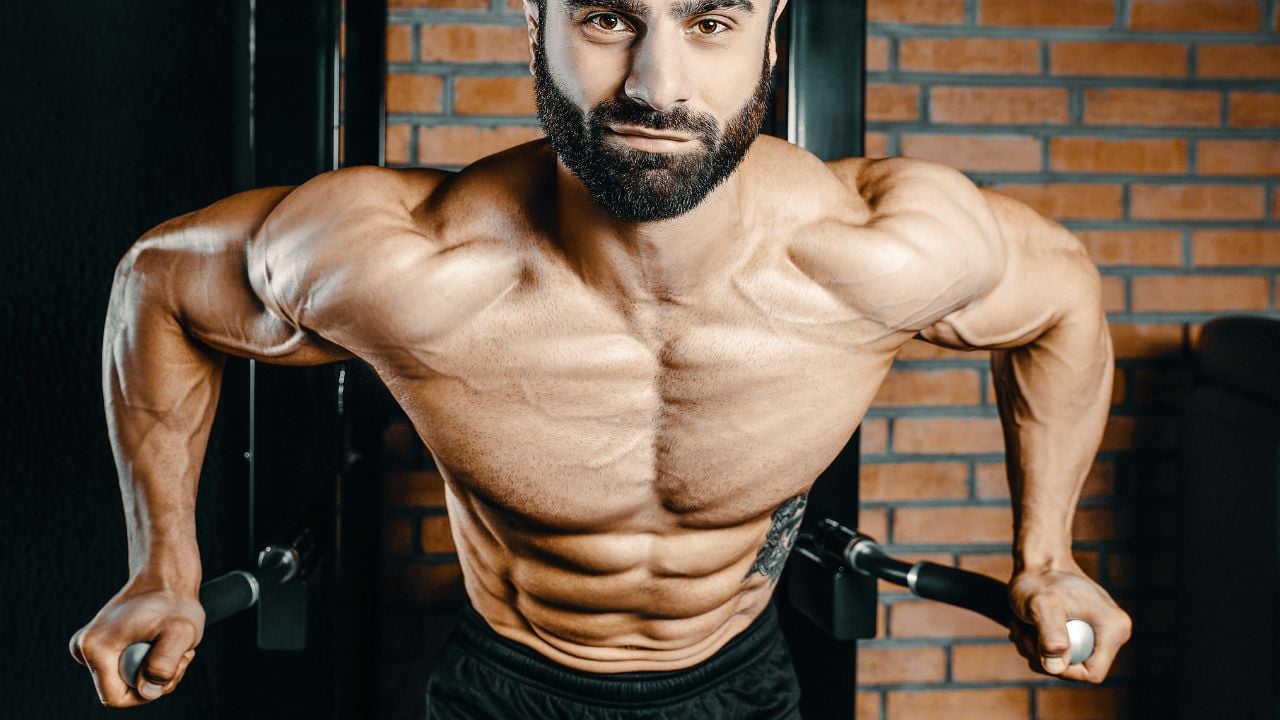
- At Home Beginner Bodyweight Shoulder Exercises
- 1. I, Y, T, W
- 2. Incline Push-Ups
- 3. Side Plank
- 4. Bench Dips
- 5. Bird Dog Exercise
- Intermediate Bodyweight Shoulder Exercises At Home
- 6. Plank To Push-up
- 7. Plank to alternate pike
- 8. Tabletop Reverse Pike
- 9. Crab Walk
- 10. Hindu Push Up
- 11. Archer Push-Up
- 12. Shoulder Tap Push Up
- 13. Plank with Arm Extension
- 14. Stability Ball Push Up
- Advanced Bodyweight Shoulder Exercises
- 15. High reverse plank
- 16. Inverted Row
- 17. Pike Push Up
- 18. Clapping push-up
- 19. Elevated pike push-up
- 20. Handstand Push Up
- 21. Parallel Bar Dip
- Know About Shoulder Muscles
- Deltoids
- Rotator cuff
- Trapezius
- Benefits of Bodyweight Shoulder Exercises
- Bodyweight Shoulder Workout Routine and Plan
- Beginner Bodyweight Shoulder Workout Plan
- Intermediate Bodyweight Shoulder Workout Plan
- Advance Workout Plan
- How To Progress Bodyweight Shoulder Training
- FAQs
- Can you build shoulders without weights?
- Do planks work shoulders?
- Do pushups work shoulders?
- Takeaways
At Home Beginner Bodyweight Shoulder Exercises
Beginner bodyweight shoulder exercises are designed for individuals who are new to working out or who have limited upper body strength.
Here are some examples of beginner bodyweight shoulder exercises:
1. I, Y, T, W
These exercises focus on the shoulder and back muscles, mainly the middle and lower part of the trapezius.
They also hit all the rotator cuff muscles which include the infraspinatus, subscapularis, teres minor, and supraspinatus muscles.
These work together to stabilize the shoulder and move the arm.
How To Do
- Lay with your stomach flat on the ground with your arms and legs fully extended.
- Point your toes away from your body and fully extend your elbows and fingers, positioning your palms facing inwards.
- Brace your abdominal muscles to stabilize your spine, depress and retract your scapulae (pull shoulders back and down).
- Attempt to hold these positions (I, Y, T, W) throughout the exercise.
- Align your head with your thoracic (upper) spine.
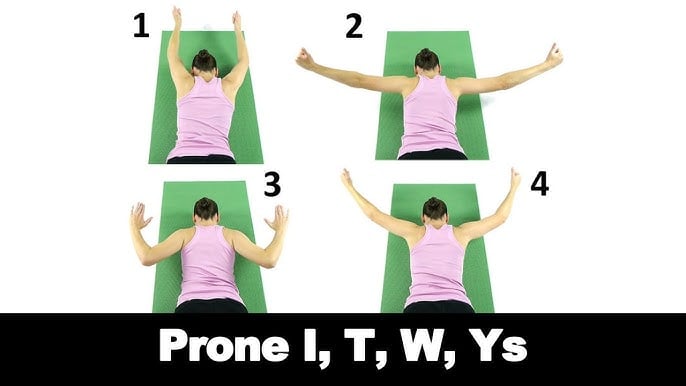
Pro Tips
- Try holding for only 5 or 10 seconds for the first time, and work up to 30 seconds in future workouts.
- To increase the difficulty for either version, add a 1-3 pound weight in each hand.
- Do not hold your breath. Breathe regularly.
2. Incline Push-Ups
Incline push-ups are a variation of the traditional push-up exercise that targets the shoulders, chest, and triceps.
The push-ups will be 50% easier if you have a 45-degree incline angle with your feet below your head, than if you have a horizontal angle.
They are a great option for individuals who are looking to progress from knee push-ups or wall push-ups.

How To Do
- Stand in front of the bench. Place the hands shoulder-width apart on the edge of the bench.
- Adopt an incline plank position by extending the legs backward until the legs and back form a straight line.
- Slowly bend the arms to lower the chest toward the bench.
- Remember to keep the elbows and arms close to the body.
- Slowly push the body away from the bench, extending the arms but maintaining a slight bend in the elbow.
Pro Tips
- Stand at a comfortable distance from the bench.
- For the incline push-ups, begin by performing 2–3 sets of 6–8 repetitions. Add more reps and sets as you build strength.
3. Side Plank
The side plank is one of the best bodyweight exercises for strengthening the core and shoulder muscles. It is a great exercise for building stability and strength in these areas.
To make the exercise more challenging, you can add a leg lift by raising the top leg towards the ceiling while holding the side plank position

How To Do
- To perform a side plank, start by lying on your side with your legs straight and your feet together.
- Prop yourself up on your elbow and forearm, and raise your hips off the ground.
- Your body should be in a straight line from your head to your feet.
- Hold this position for a specific time (10–30 seconds) as per your comfort and repeat the same for the other side.
Pro Tips
- Keep your body in a straight line, avoid letting your hips sag or lifting too high
- Start with less time and gradually increase it as you progress
4. Bench Dips
A bench dip is a medium-intensity exercise that uses your own bodyweight to strengthen your triceps and deltoid.
You can do bench dips almost anywhere, making them great for doing bodyweight shoulder exercises at home.

How To Do
- place your hands on a bench or a stable surface behind you, with your fingers facing forward.
- Your feet should be placed on the ground in front of you, with your legs bent at a 90-degree angle.
- Lower your body towards the ground by bending your arms.
- Then push yourself back up to the starting position by extending your arms.
Pro Tips
- Keep your back close to the bench and avoid letting your shoulders dip too low.
- Start with fewer repetitions and gradually increase as you progress
5. Bird Dog Exercise
The bird dog is a bodyweight exercise that looks elegant and is also very effective for training the abs muscles, lower back, and shoulder muscles.
Several other muscles are also addressed, including the glutes and hamstring.

How To Do
- Get on your knees and place your hands on the floor in front of your body at shoulder width.
- Contract your abs and lift one hand and the opposite knee slightly off the floor.
- Now extend your arm and leg all the way out.
- Try to form a straight plane from your hand to your foot.
- Hold this position for about 10 seconds and then return to the starting position.
- Repeat the exercise with the other side.
Pro Tips
- Keep your core tight and engage your lower back muscles throughout the exercise
- Don’t raise your leg and arm higher than your back.
Intermediate Bodyweight Shoulder Exercises At Home
When your shoulders are strong and stable, you can move on to more advanced exercises. Intermediate shoulder exercises help you work your shoulders harder by doing them in different ways and positions.
Introducing instability and increasing loads placed on the shoulders will encourage further adaptation and growth.
Some key intermediate bodyweight shoulder exercises we’ll cover include pike pushups, shoulder taps, and handstand holds against the wall.
6. Plank To Push-up
The Plank Push up — also known as the “plank-to-pushup” is the combination of the two exercises (Plank and Push-up.), that provide the benefits of both.
This exercise works various upper body muscles, including the chest, shoulders, and triceps, more dynamically than a standard plank.
The plank push-up is simple to do. You alternate between a high plank and a forearm plank with control, then push your body back up one arm at a time.
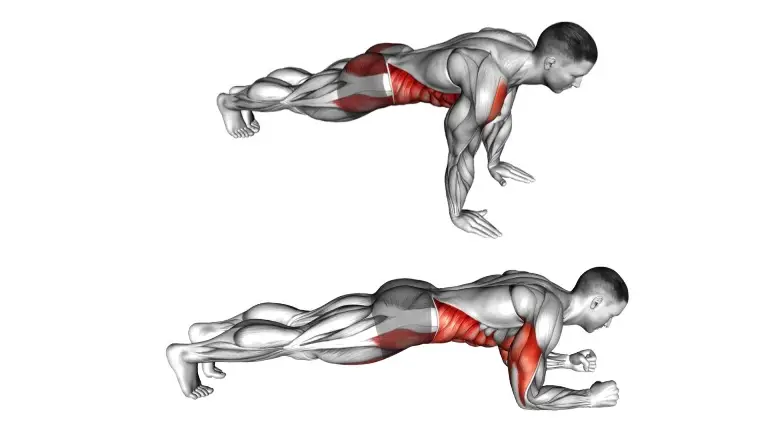
How To Do
- Start in a plank position with your hands placed directly under your shoulders and your feet together.
- Keep your core tight and maintain a straight line from your head to your heels.
- From the plank position, lower yourself down into a push-up by bending your arms.
- Keep your body in a straight line and avoid sagging your hips or lifting your back.
- Push yourself back up to the starting position, fully extending your arms.
Pro Tips
- Set your hands slightly wider than shoulder-width apart for a more stable foundation.
- Use an exercise mat under your arms to increase comfort and stability.
- Avoid letting your hips sag during the exercise
7. Plank to alternate pike
The plank pike is an effective exercise that develops shoulder strength and core stability while increasing stability and mobility throughout the spine and hip region.
It is a more advanced variation of the plank exercise and requires a good level of core and shoulder stability.
You should include this exercise in your shoulder workout routine.
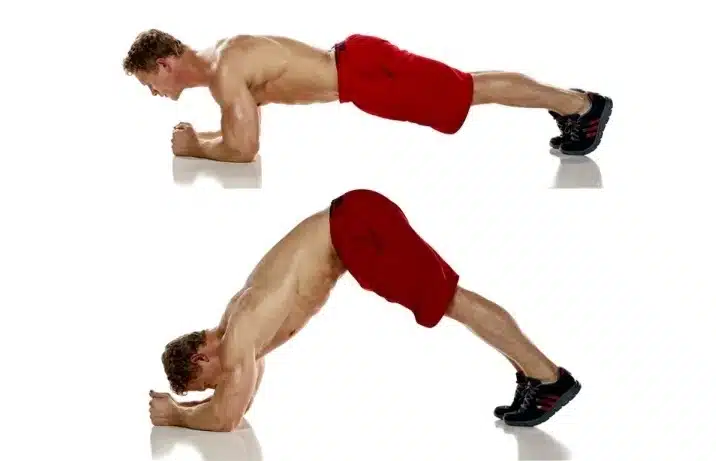
How To Do
- start in a plank position with your hands placed directly under your shoulders and your feet together.
- Keep your core tight and maintain a straight line from your head to your heels.
- From the plank position, raise your hips towards the ceiling by keeping your hands and feet in place.
- The movement should resemble an inverted V shape.
- Slowly lower your hips back down to the starting position.
Pro Tips
- Do not allow your back to round at any point.
8. Tabletop Reverse Pike
Table-top reverse pike targets and trains your arms, shoulders, and core and improves your overall strength and stability. It also engages your glutes, and legs.
This exercise intensely works the core muscles, particularly the lower abdominals and obliques.
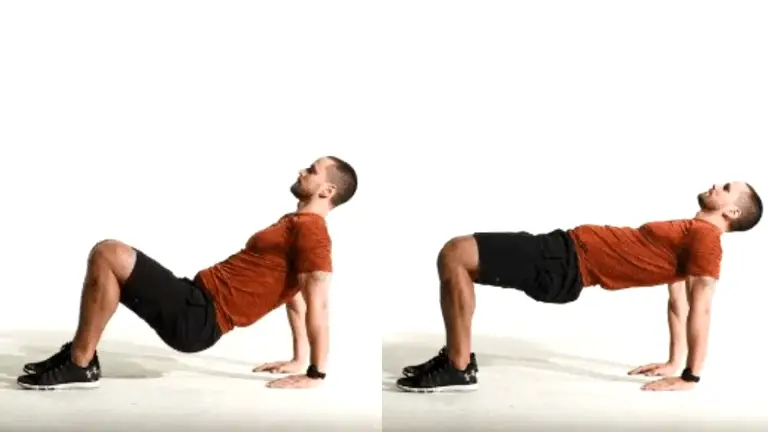
How To Do
- Sit on the floor with your legs extended in front of you.
- Place your palms, with fingers spread wide, on the floor slightly behind and outside your hips.
- Press palms into the ground and lift hips off the floor until knees are at 90 degrees, and body is parallel with the floor.
- Arms should be straight with hands directly under the shoulders, with ankles directly under knees.
- Engage your abs and balance on your heels and hands.
- Hold this position for a set amount of time.
Pro Tips
- Don’t allow your hips to sag or your shoulders to hunch.
- Don’t let your back arch.
9. Crab Walk
The Crab walk is an excellent bodyweight exercise that particularly works the upper arms, shoulders, legs, and core.
It is excellent for toning, effectively targeting all your muscle groups and working them difficult to build strength.
Moves like the crab walk are great total-body exercises that don’t require any additional equipment. It is an ideal move to perform when you don’t have a lot of time or fitness gear on hand.
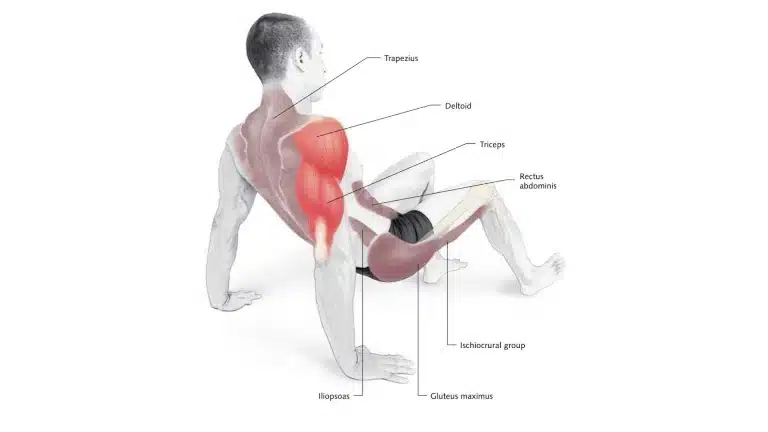
How To Do
- Position your hands and feet so that they are flat on the ground, and you are face up.
- Lift your butt up off the ground by tightening your gluteal muscles.
- Begin “walking” by first moving your hands and then your feet.
- Avoid excessive shoulder strain by moving your hands no more than 6 to 8 inches (15 to 20 cm) at a time.
Pro Tips
- As a caution, do not let your feet move too fast for your upper body so as not to injure your shoulders.
- Control your movements
10. Hindu Push Up
The Hindu push-up, also known as a “Dhand” , is a bodyweight exercise that targets the shoulders, chest, and triceps, as well as the core and back muscles.
It is a dynamic exercise that combines elements of yoga and traditional push-ups to create a more challenging shoulder workout.
It provides better strength and endurance to the muscles. It is a complete exercise that gives the body a compounded effect.

How To Do
- Start in a downward dog pose, with your hands shoulder-width apart, your body in a V shape.
- Bend your elbows and lower your chest until it’s just above the floor..
- In a scooping motion, scoop your head upward while arching your lower and upper back and go into cobra pose.
- Return to the starting position, you do not need to reverse back through the sweeping, arching motion.
- Simply push back into the starting position.
Pro Tips
- Engage your core, relax the spine and neck, open the shoulders and keep the movement smooth.
- Keep the elbows close to your body.
11. Archer Push-Up
In Archer push-up, the arms are kept wider than the normal push-up position and as you lower your body, you transfer the majority of your weight to one of your hands and incline towards that hand while the other hand is kept straight.
Simultaneously move your body to both sides. You have to maintain a tight, steady, and controlled body to perform an Archer push-up.

How To Do
- Start in a standard push up position.
- Maintain a strong core position and shift your upper body toward your right side.
- Pull your right chest toward your right hand as you bend your right elbow.
- As you lower toward the right side, allow your left arm to straighten.
- Your left arm should be fully extended, forming a straight line from your shoulder to your hand.
- Repeat for your desired number of repetitions, switch sides.
Pro Tips
- Make sure your body is in the straight line from head to the feet
12. Shoulder Tap Push Up
Shoulder Tap Push-Up is a full-body strength move that focuses on your arms, shoulder, and chest while also strengthening your core.
It can be challenging, especially if you’re new to them.
To make them easier, you can do them on your knees instead of your toes

How To Do
- Start in a traditional push-up position
- Lower yourself by flexing your elbows so that your chest comes within a few inches of the floor.
- Raise your body to the starting position by pushing up with your arms.
- Tap your left hand to your right shoulder.
- Place it back on the floor and repeat your next push up and shoulder tap with another hand.
Pro Tips
- Tighten your core, engage your glutes, and keep your spine, head and neck aligned.
- Your arms should resemble an arrow in the bottom position, not a “T”
13. Plank with Arm Extension
The plank with arm extension is an advanced plank variation that requires you to hold the plank with one arm raised in front of you.
The main objective of this bodyweight exercise is to strengthen the core and shoulder muscles.
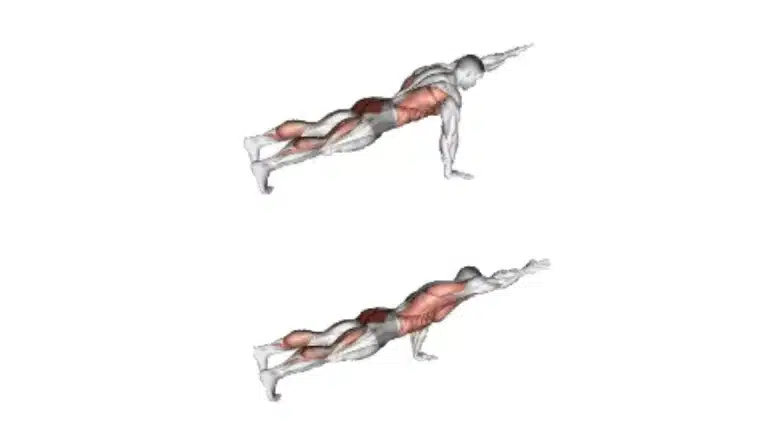
How To Do
- Start in a high plank position.
- Raise and straighten your right arm, and hold it so that it’s parallel to the rest of your body.
- Hold this position for a set amount of time and slowly lower to the starting position.
- Then raise your other arm and repeat.
Pro Tips
- Ensure your body is straight and rigid.
14. Stability Ball Push Up
Studies have shown that stability ball push-ups significantly activate more muscles compared to traditional push-ups.
Using an exercise ball on a hard surface can make exercise harder. This helps the shoulders and triceps work more.
You’ll have to focus on maintaining your balance on the ball, which allows you to work more.

How To Do
- Lay with your chest on the stability ball. Place your hands on the ball at the sides of your chest.
- Place feet back and lean forward so that your chest is directly over the ball, and you are supported on your toes.
- Push your body up until your arms are almost straight. Pause here for a second.
- Breathe out and extend your arms to bring your upper body back to the starting position.
Pro Tips
- Do not let your lower back sag or your butt rise. Ensure your body is straight and rigid.
- Keep your glutes and core muscles contracted.
Advanced Bodyweight Shoulder Exercises
Advanced bodyweight shoulder exercises are designed for individuals who have a high level of fitness and are looking to push themselves to the next level.
Here are some examples of advanced bodyweight shoulder exercises:
15. High reverse plank
The reverse plank exercise is a great bodyweight shoulder exercise for strengthening your core and the key muscles of your posterior chain, namely, your erector spinae, gluteus maximus, and hamstrings.
Beginners should start with learning the regular plank.
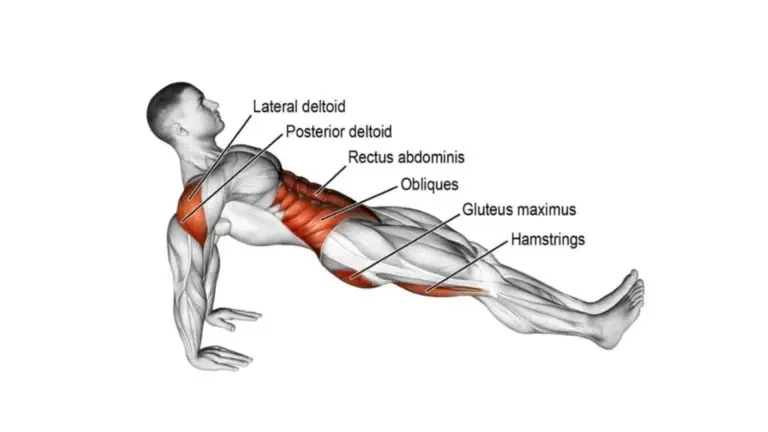
How To Do
- Place your palms, with fingers spread wide, on the floor slightly behind and outside your hips.
- Raise your hips off the floor until your body is straight.
- Keep your arms and legs straight and look up to the ceiling.
- Hold this position for a set amount of time.
Pro Tips
- Your arms should be vertical and your body should be perfectly straight.
- Don’t allow your hips to sag or your shoulders to hunch.
16. Inverted Row
The inverted row, also known as the body row, is an efficient bodyweight workout that targets the shoulders and other upper body muscles.
Unlike pull-ups, which primarily target the latissimus dorsi (back muscles), the inverted row emphasizes the middle and lower trapezius and rear delt.

How To Do
- Adjust the height of the chair and bar so that it’s a little higher than arm’s length from the floor.
- Lie under the bar with your legs and body straight.
- Grasp the bar with an overhand grip that’s a little wider than shoulder width.
- Keeping your legs and body straight, exhale as you pull your chest up to the bar.
- Hold for a count of two and squeeze your back muscles.
- Inhale as you lower your body until your arms and shoulders are fully extended. Repeat.
Pro Tips
- Do not allow your butt to sag. Flex your tummy, squeeze your butt cheeks, and keep your body stiff from your head to your toe.
- Make sure you go down completely. Lower your body and ensure the arms are extended and raise your body until you touch the chest touches the bar.
17. Pike Push Up
Pike Push-ups are a variation of the push-up that increases strength and stability in the shoulders and triceps.
The hands are approximately 1-1.5x shoulder width, and the head is in line with a neutral spine.
Pike push up is a fairly advanced movement that requires extra attention to form and quality over quantity.
It is important to have enough general mobility before attempting any exercise, and beginners should start with classic push-ups before transitioning to pike push-ups.

How To Do
- Start in a standard push-up position with your hands slightly wider than shoulder-width apart and elbows completely locked out.
- Lift the hips up and back until your body forms an inverted V shape.
- Keep your arms and legs as straight as you possibly can.
- Slowly lower the top of your head towards the ground.
- Once your head is about to contact the ground, pause for a second.
- Then slowly push back until your arms are straight, and you’re in the inverted V position.
Pro Tips
- Be sure to maintain a high level of control throughout the entire movement.
- Never let your head touch the floor, but try to get as close to it as you can.
- Slow down all of your movements and really stay focused on your form.
18. Clapping push-up
Clapping Push-ups is an advanced bodyweight exercise that works your chest, triceps, abs, and shoulders.
With this type of push-up, a “jumping” element is added to the exercise to make it more challenging and explosive.

How To Do
- Start in a standard Push-Ups
- Start to lower your body as if you’re going to do a push-up until your chest is almost touching the floor.
- Reverse the motion by pushing hard through the palms, just as your arms reach full extension, pull your hands up off the floor.
- Rapidly clapping the hands together and placing them back in the original position.
Pro Tips
- Do not let the elbows flare out.
- Keep the elbows close to your sides throughout.
19. Elevated pike push-up
The elevated pike push-up is a great exercise for building upper body strength, especially in the shoulders and triceps.
The elevated position also increases the demand on the core muscles, making it a great exercise for targeting the core as well.
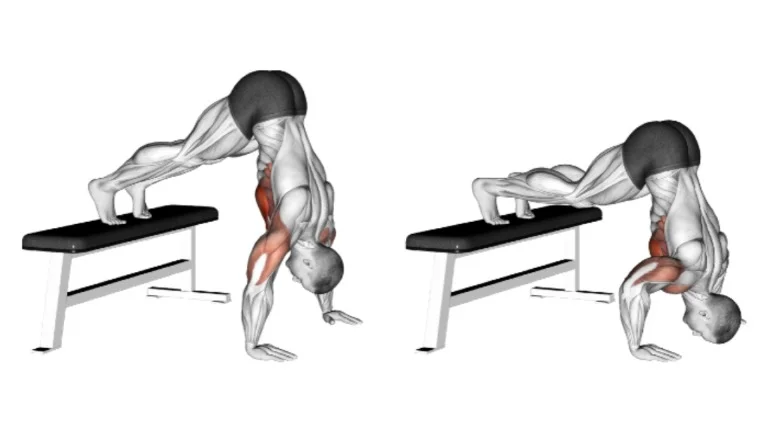
How To Do
- Start in a decline push-up position.
- Lift the hips up and back until your body forms an inverted V shape.
- Slowly lower the top of your head towards the ground.
- Once your head is about to contact the ground, pause for a second.
- Then slowly push back up until your arms are straight, and you’re in the inverted V position.
Pro Tips
- Be sure to have first mastered the pike press before trying the elevated pike press.
- Make sure you maintain control throughout the movement.
20. Handstand Push Up
The handstand push-up also called the vertical push-up is a type of push-up exercise where the body is positioned in a handstand.
It is an advanced bodyweight exercise that targets the shoulders, as well as the arms and core.
They require a high degree of upper body strength and skill and should be attempted only after proper training and conditioning.

How To Do
- start in a handstand position against a wall, with your hands placed on the ground and your body in a straight line.
- Slowly lower your body down towards the ground by bending your arms, keeping your body in a straight line.
- Push your body back up to the starting position by extending your arms.
Pro Tips
- It is important to have a spotter or use a wall for safety and support when attempting this exercise.
21. Parallel Bar Dip
The Parallel Bar Dip is a classic exercise primarily targeting the chest, triceps, and shoulders. This exercise targets the anterior (front) deltoids.
No fancy equipment needed! Dips can be done anywhere with parallel bars.

How To Do
- Grasp the bars with your hands shoulder-width apart, thumbs pointing inwards or outwards (both variations are acceptable).
- Straighten your arms and legs, forming a straight line from head to heels. Engage your core and keep your shoulders down.
- Bend your elbows and lower your body towards the ground. Do this slowly. A
- Aim to bring your chest close to the bars. level. Maintain a strong core engagement and keep your back straight.
- Press through your arms to straighten your elbows and return to the starting position. Exhale as you push up.
Pro Tips
- A little forward body bend will hit the chest and shoulder muscles harder.
- Hold a dumbbell between your legs if you need additional resistance.
Know About Shoulder Muscles
The shoulders are made up of several muscles that work together to provide a wide range of motion and stability.
The main muscles of the shoulder are the deltoids, rotator cuff, and trapezius.
Deltoids
In fitness, “shoulder exercises” refers to resistance exercises that target the deltoid muscle.
While the deltoid is technically a single muscle, anatomically speaking it has three distinct sets of muscles fibers and muscle bellies, which are referred to as “heads.
- The anterior deltoid (In front),
- lateral deltoid (at the side), and
- Posterior deltoid (behind),
The deltoids are responsible for shoulder flexion, extension, and abduction.
Rotator cuff
The rotator cuff is made up of four small muscles that attach to the shoulder blade and help to stabilize the shoulder joint.
The supraspinatus, infraspinatus, teres minor, and subscapularis muscles all make up the rotator cuff.
Trapezius
The trapezius muscle is a large muscle that runs from the base of the skull to the middle of the back and is responsible for shoulder elevation, depression, and rotation.

Benefits of Bodyweight Shoulder Exercises
There are many good reasons to include doing shoulder exercises at home using your own bodyweight in your deltoid workout plan.
- You can do bodyweight exercises anywhere and anytime, even if you don’t have a gym or weights nearby.
- Bodyweight exercises are a cost-effective way to workout, since they don’t require any equipment.
- The bodyweight workouts are adaptable and can be tailored to meet a variety of fitness requirements, from the novice to the expert.
- Many bodyweight exercises target the shoulders, which helps to strengthen and stabilize the muscles that support good posture.
- Stronger shoulders can help to reduce the risk of injury and pain. Bodyweight exercises that work on the shoulders can help to strengthen the rotator cuff muscles, which are essential for shoulder stability.
- It can help to improve upper body strength, which can be beneficial for daily activities such as carrying heavy bags or lifting objects.
- It can help to improve overall fitness by building strength, endurance, and flexibility.
- Bodyweight shoulder exercises allow the joints to move naturally within their range of motion by creating more joint stability.
- Bodyweight workouts are perfect for the at-home exerciser with the limited space.
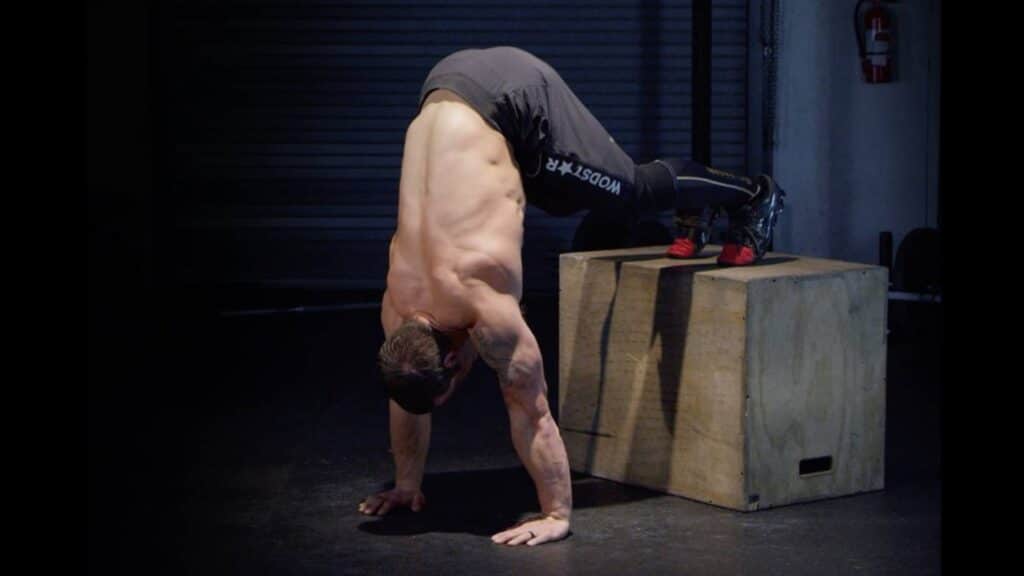
Bodyweight Shoulder Workout Routine and Plan
Bodyweight shoulder exercises can be modified to suit different fitness levels, from beginner to advanced.
When designing a workout plan, it’s important to start with a lower training volume and gradually increase it as you build strength and endurance.
Here are some tips for incorporating bodyweight shoulder exercises into your routine:
- Schedule in specific days for shoulder exercises: Designate specific days of the week for shoulder exercises and stick to them.
- Incorporate them into your full-body workouts: You can also incorporate them into your full-body workout routine. This will help to ensure that you are working on all muscle groups and also keep your workout interesting.
- Start with fewer repetitions: Start with fewer repetitions, and gradually increase as you build strength and endurance.
- Be consistent: Consistency is key when it comes to bodyweight shoulder exercises. Make sure to stick to your routine and be consistent with your workouts.
- Mix it up: Mixing up your exercises can help to prevent boredom and target different muscle groups.
Here is a list of shoulder exercises that you can do with your bodyweight, whether you’re a beginner, intermediate, or advanced.
Beginner Bodyweight Shoulder Workout Plan
For those new to bodyweight exercises, it’s important to start with exercises that are relatively easy to perform and to focus on proper form.
Some good options for beginners include. I, Y, T, W, wall push-ups, knee push-ups, and bird bog Pose.
| Exercise | Sets | Reps/Duration |
|---|---|---|
| Warm-up | – | 5-min light cardio |
| I, Y, T, W | 2-3 | 3-4 reps each |
| Incline Push-ups | 3 | 8-10 reps |
| Side Plank | 3-4 | 10-20 seconds hold |
| Bird Dog | 3 | 8-10 reps |
| Cool-down | – | 5-min stretching |
Intermediate Bodyweight Shoulder Workout Plan
As you build strength and confidence, you can progress to more challenging exercises.
Intermediate bodyweight shoulder exercises include regular push-ups, crab walk, and Hindu push-up.
Tabletop Reverse Pike and plank can also be included in intermediate level.
Here is a sample bodyweight shoulder workout plan for intermediates:
| Exercise | Sets | Reps/Duration |
|---|---|---|
| Warm-up | – | 5-min light cardio |
| Plank To Push-up | 3 | 12-15 reps |
| Tabletop Reverse Pike | 3 | 10-20 seconds hold |
| Dips | 3 | 12-15 reps |
| Crab Walk | 3 | 12-15 reps |
| Shoulder Tap Push Up | 3 | 8-12 reps |
| Cool-down | – | 5-min cool-down |
Advance Workout Plan
For those who are looking for a more challenging workout, advanced bodyweight shoulder exercises include handstand push-ups, Pike push up, and inverted row.
These exercises require a high degree of upper body strength and skill, so it’s important to progress slowly and focus on proper form.
| Exercise | Sets | Reps/Duration |
|---|---|---|
| Warm-up | – | 5-min cardio warm-up |
| Pike Push Up | 3 | 8-12 reps |
| Handstand Push-ups | 3 | 8-10 reps |
| High Reverse Plank | 3 | 10-20 sec hold |
| Clapping Push-Up | 3 | 8-12 reps |
| Handstand Walk | 3 | – |
| Cool-down | – | 5-min cool-down |
This workout can be done 2-3 times a week, but it’s important to give your body rest.
As you progress, you can increase the number of reps, sets, and add difficulty to the exercises.
How To Progress Bodyweight Shoulder Training
Here are some ways to progress your bodyweight shoulder training:
- Increase the volume: As you progress, you can increase the number of repetitions, sets, or the duration of the exercise. This will increase the intensity of your workout and challenge your muscles further.
- Add resistance: You can add resistance to your exercises by using resistance bands or weights. This will increase the intensity of your workout and help to build muscle mass.
- Increase the difficulty level: As you progress, you can try more advanced exercises such as one-arm push-ups, muscle-ups, and handstand push-ups. This will increase the intensity of your workout and challenge your muscles further.
- Incorporate new exercises: Incorporating new exercises into your routine can help to target different muscle groups and prevent boredom.
- Prioritize form: As you progress, it’s important to focus on proper form to ensure that you are targeting the shoulders effectively and to prevent injury.
FAQs
Can you build shoulders without weights?
Yes, it is possible to build shoulders without weights.
Bodyweight exercises such as push-ups, pike push-ups, dips, and planks can effectively target the shoulders and help to build muscle mass and strength.
Do planks work shoulders?
Planks are a great exercise for targeting the shoulders, as well as the core, back and glutes.
Planks work the shoulders by engaging the shoulder blades and the rotator cuff muscles, which are responsible for stability and movement of the shoulders.
By holding the plank position, the shoulders are actively working to hold the body in a stable position, which can help to build muscle and strength.
Do pushups work shoulders?
Yes, push-ups can effectively work the shoulders. Push-ups target the anterior deltoids, which are the muscles located in the front of the shoulders. They also target the triceps and chest muscles.
As you progress, you can add variation to the push-up such as incline push-ups, decline push-ups, pike push-ups and more to target the shoulders specifically.
Takeaways
Bodyweight shoulder exercises are a great way to build strength and muscle mass in the shoulders, as well as improving overall fitness and stability.
There are exercises suitable for beginners, intermediates and advanced individuals.
These bodyweight shoulder exercises are highly recommended for anyone interested in building a wider shoulder and who wants to gain strength.
It is easy to do and requires no more scientific details and fancy equipment. Incorporate some exercise from these 21 exercises into your workout regimen.
If you do these bodyweight shoulder exercises consistently, the results will speak by themselves.
Thanks for reading, enjoy your workout!
References
- Dhahbi W, Chaabene H, Chaouachi A, Padulo J, Behm DG, Cochrane J, Burnett A, Chamari K. Kinetic analysis of push-up exercises: a systematic review with practical recommendations. Sports Biomech. 2022 Jan;21(1):1-40.
- Calatayud J, Borreani S, Colado JC, Martín FF, Rogers ME, Behm DG, Andersen LL. Muscle Activation during Push-Ups with Different Suspension Training Systems. J Sports Sci Med. 2014 Sep 1;13(3):502-10. PMID: 25177174; PMCID: PMC4126284.
- Borreani S, Calatayud J, Colado JC, Moya-Nájera D, Triplett NT, Martin F. Muscle activation during push-ups performed under stable and unstable conditions. J Exerc Sci Fit. 2015 Dec;13(2):94-98. doi: 10.1016/j.jesf.2015.07.002. Epub 2015 Sep 2. PMID: 29541105; PMCID: PMC5812863.
- Plummer HA, Plosser SM, Diaz PR, Lobb NJ, Michener LA. Effectiveness of a Shoulder Exercise Program in Division I Collegiate Baseball Players During the Fall Season. Int J Sports Phys Ther. 2022 Feb 1;17(2):247-258. doi: 10.26603/001c.31638. PMID: 35136694; PMCID: PMC8805093.

Manish brings over 10 years of hands-on experience in weight lifting and fat loss to fitness coaching. He specializes in gym-based training and has a lot of knowledge about exercise, lifting technique, biomechanics, and more.
Through “Fit Life Regime,” he generously shares the insights he’s gained over a decade in the field. His goal is to equip others with the knowledge to start their own fitness journey.
